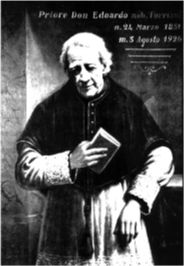DON EDOARDO nob. TORRIANI, LAST PRIOR OF THE FAMILY
At dawn on August 2, 1926 Don Edoardo nob. Torriani, Prior Prior of della Torre passed away.
He will be remembered for his intelligence and gentleness.
His magnificent work has been almost forgotten because few know about his fruitful history studies, studies to which he dedicated his whole life.
He was born in Mendrisio, on the 24th March 1851, Rosamunda Hungerkhau- sen of Münich and Alexander nob. Torriani were his parents.

He started his studies at the Papio College at Como. He then went to to the seminary at Lodi, where he finished his studies at a very young age.
He was therefore ordinated as a priest on 1872 only after having studied in the Seminary Maggiore at Como He practiced his holy mission in the parishes of Sessa, Genestrerio, Rancate, Salorino, and finally in 1879 he took possession of the Prioria della Torre in Mendrisio. For more than 50 years he served with zealousness and humility. He had a holy manger built for the church and he embellished the Church of an artistic picture of the famous painter Francesco Torriani, wich represents the martyrdom of Sant‘Orsola.
He travelled widely to study. He left for the first time to Holy Land in 1886 and in 1893 he undertook a second one. Again later he visited Spain, Italy, Germany and France.
His passion for history and poetry brought him meanwhile to write and to study old documents and books. With jobs patience he catalogued around 20'000 writings, documents and deeds wich belonged to the Torriani archives. After long studies of interpretation they were reviewed in 1914.
With his summaries of thousand of old and almost illegible manuscripts he set the base upon which one can build four centuries of memories of this splendid region: Mendrisiotto. A considerable amount of his works has been published. His love of Germany was almost partisan so he could not abstain from prising it while writing against its enemy France.
In an effort to honour those who possessed an excellent ingeniousness, a good moral character and cultivated studies, the famous Italian academy Arcadia pointed him out in 1890 as an outstanding literate and scientist and so he was included as member of the literary Republic.
In the same year the academy Tiberina recognised his scientific and literary merits and made him a member. In 1891 he was elected to be an active member of the literary academy of the Società Cattollica Istruttiva Romana. In 1903 he was admitted to join the archaeological society of Como.
Futhermore, in 1908, he joined the historical section of the “Wissenschaft und Kunst” at Luzern and in 1921 he was also made member of the “Allgemeine Geschichtforschende Gesellschaft der Schweiz.”
He was a closed friend of Emilio Motta and thus collaborated with the Historical Bulletin of Italian Switzerland.
His poetry was intentionally moral-satirical, his rhyme simple and smooth while his prose was ambedded in a deep historical knowledge. Of his many works, we point out the main one in Latin: “Germanorum contra Gallos”, dedicated to Caesar William II.
In prose:
Storia ecclesiastica di Mendrisio
Il santuario di San Giacomo di Compostella ed una rapida veduta della Spagna
Diario di un viaggio in Palestina
I tre cardinali svizzeri
Dell’avvenire del cattolicesimo in Oriente
I russi e gli azzurri (commedia in tre atti di carattere politico locale)
Filippo Witt ed i cannibali francesi
Vade Mecum contro I'attrabile, la noia e l'ignoranza
Satire sulla vita politica del Cantone Ticino
Elogio alla Germania.
These works were followed by "brochures of memories and notes" on the Parish of San Sisino, on the suppressed monastery of the Served Fathers and on that of the Orsolines in Mendrisio.
In poetry:
Le nazioni
Viaggio secondo in terra santa
Trenta sonetti
Roma prima e dopo il 20 settembre
Napoleone I dinnanzi alle piramidi
Laon
Parigi e la Comune
La sentenza (last song of an unpublished poem)
Litanie Lauretane
Fasti di Guglielmo I.
His most remarkable works were “The ecclesiastical history of Mendrisio” and “The nations “. The former gives us news about our region in the past centuries; the latest exposes his poetic vain and historical culture.
In every circumstance of his life he was fair, honest, simple, careful, zealous. All in all he was a man of his time when bona fide was a virtue, and art of living and that of the spoken words that hide inner thoughts reigned.
His humbleness and his historical personality will be reborn in those who appreciate the true value of his works.
From "History of Mendrisio" by Prof. Mario Medici
